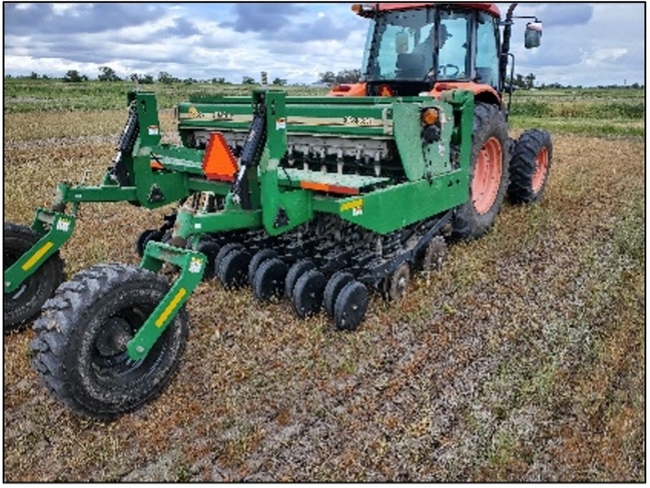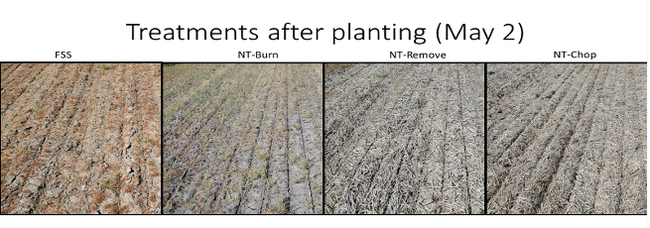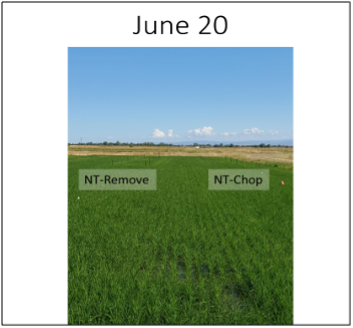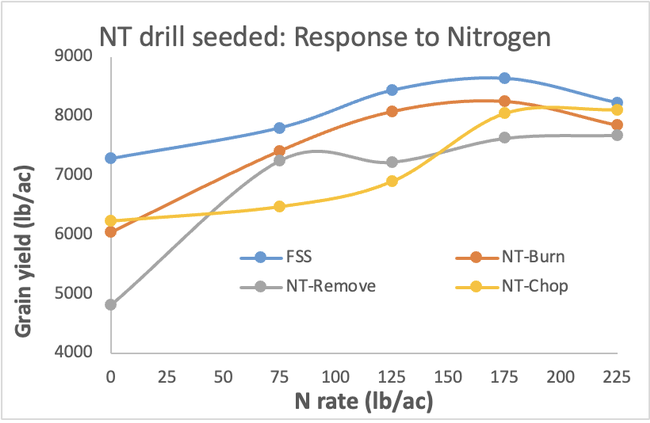- Author: Bruce Linquist
- Editor: Taiyu Guan
- Editor: Consuelo B Baez Vega
I wrote in a previous Newsletter article about some new research we are doing testing no-till drill seeded rice production. Why are we doing this? It is one way to save considerable amounts of irrigation water. We estimate that up to 0.5 ac ft/ac of water could be saved. Water savings are due to using existing soil moisture (from the winter/spring rains) and limiting the evaporation of water during the first month of the season by not having the field flooded. Other potential benefits include reduced tillage costs, the ability to plant early, and avoiding tadpole shrimp and seed midge injury. If rotating with water-seeded systems, it is also a great way to use different modes of action to address herbicide resistant weed issues.
Briefly, to recap. This study was conducted at the Rice Experiment Station and was run by Mia Godbey (graduate student) and Ray Stogsdill, with Luis and Whitney looking at pests and weeds. We tested NT drill seeding into four different seedbeds.
- Fallow stale-seedbed (FSS): field was fallowed in 2022. It was disked and leveled then. It was not flooded during the winter. No tillage was done in 2023.
- No-till. We have three strict NT treatments. Rice was grown in 2022. After harvesting (harvested to limit ruts), the straw in the field was subjected to one of three treatments:
- Chopped (NT-Chop)
- Half removed to simulate baling (NT-Remove)
- Burned (NT-Burn)
The no-till fields were all winter flooded.
At time of planting, there were a lot of winter weeds in the NT-Burn and FSS treatments (with the wet spring we got more winter weeds than normal). While we tried to get rid of them by spraying glyphosate before drilling, many were tolerant. In the NT-Chop and NT-Remove treatments there were little to no weeds. On May 2 the fields were all planted with a Great Plains no-till drill seeder (see above) at a rate of 150 lb seed/ac. After seeding, all treatments received an initial irrigation flush on May 4 and the flush was drained on May 8. We did not apply any herbicide at planting before or after the flush.
We chose this year to have the same planting date for all treatments, but the FSS and NT-Burn treatments could have been planted in mid-April. However, the treatments with straw on the surface had too much soil moisture to be able to get equipment into the field and May 2 was the earliest we could get into these fields.
We did not apply any irrigation water after the initial flush at planting until June 2 when we applied the permanent flood. The rice was at the 4-leaf stage by this time. We got a good stand in all treatments. The stand was lowest in the NT-Chop treatment but still good. The soil moisture in the NT-Burn and FSS was starting to dry out but we did not see any moisture stress. In the NT-Chop treatment, there was still a lot of moisture beneath the straw mat. The winter weeds were still present but we saw very few other weeds coming up. Just before permanent flood, we applied urea and herbicides (Prowl, Clincher and Propanil).
After the permanent flood, the plants almost doubled in height in the first few days and were well above the water line. The winter weeds persisted into the permanent flood. However, they did not appear to affect the stand of rice.
Compared to 2022, 2023 had higher relative humidity during the season (fig. 1). According to the Williams CIMIS weather station, the average maximum relative humidity for the month of July for 2022 and 2023 was 77 and 96%, respectively, while the minimums were 19 and 44%. Higher relative humidity, combined with lower wind speeds during the months of July and August probably, may have resulted in longer periods of free moisture on plant surfaces during mornings, which allows for germination of blast spores and infection of leaves and panicles. These plots were harvested with a small plot combine on September 28. Grain yields responded to various rates of N application. Yields were highest (8640 lb/ac) in rice after fallow (FSS) followed by NT-Burn and then the NT-Remove and NT-Chopped. Yields in all treatments were highest at the 175 lb N/ac N rate. While these yields were no super high, they were comparable to the maximum yields we observed in water-seeded conventional rice at the RES which was 8490 lb/ac.
We are very encouraged by these results and will be providing greater detail in our upcoming winter grower meetings. In future years we will be looking at optimizing herbicide and fertility practices as well as quantifying water savings.







